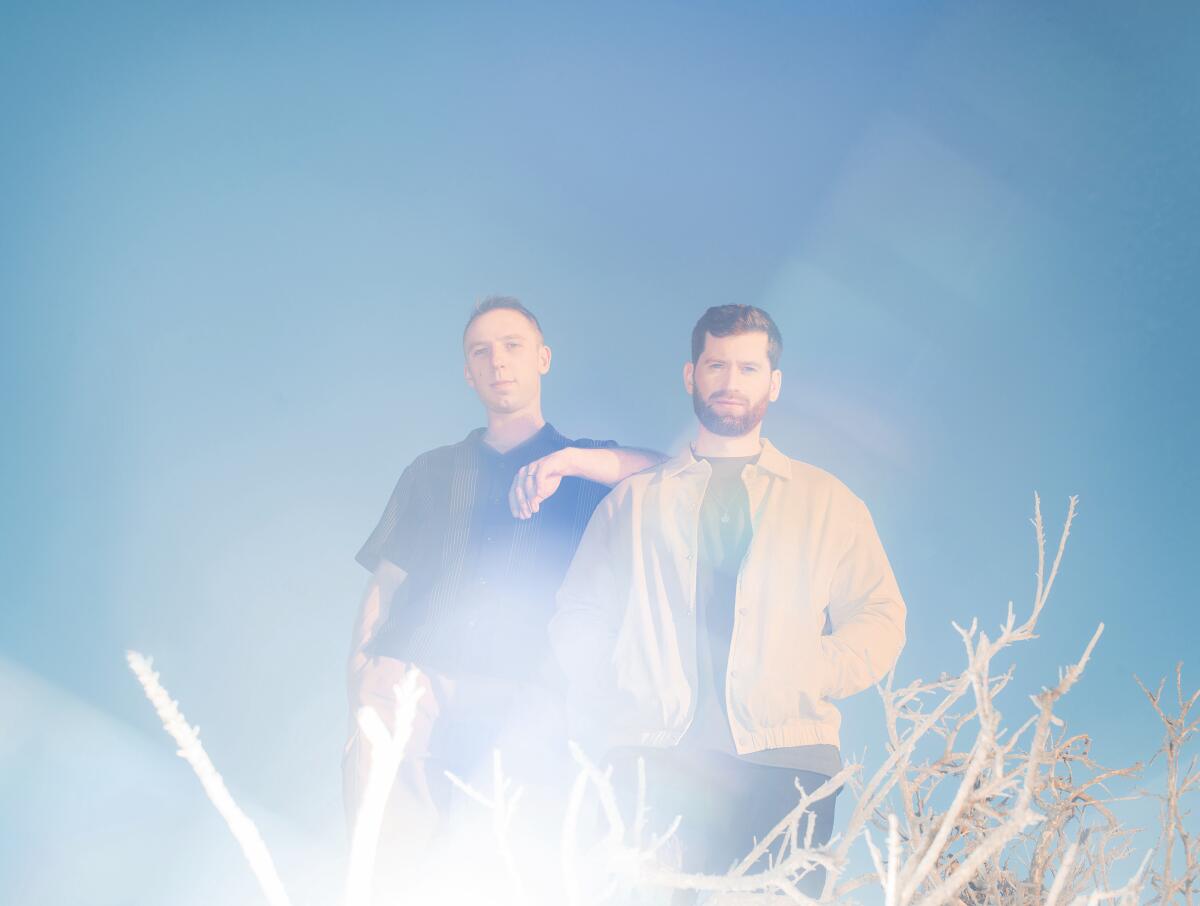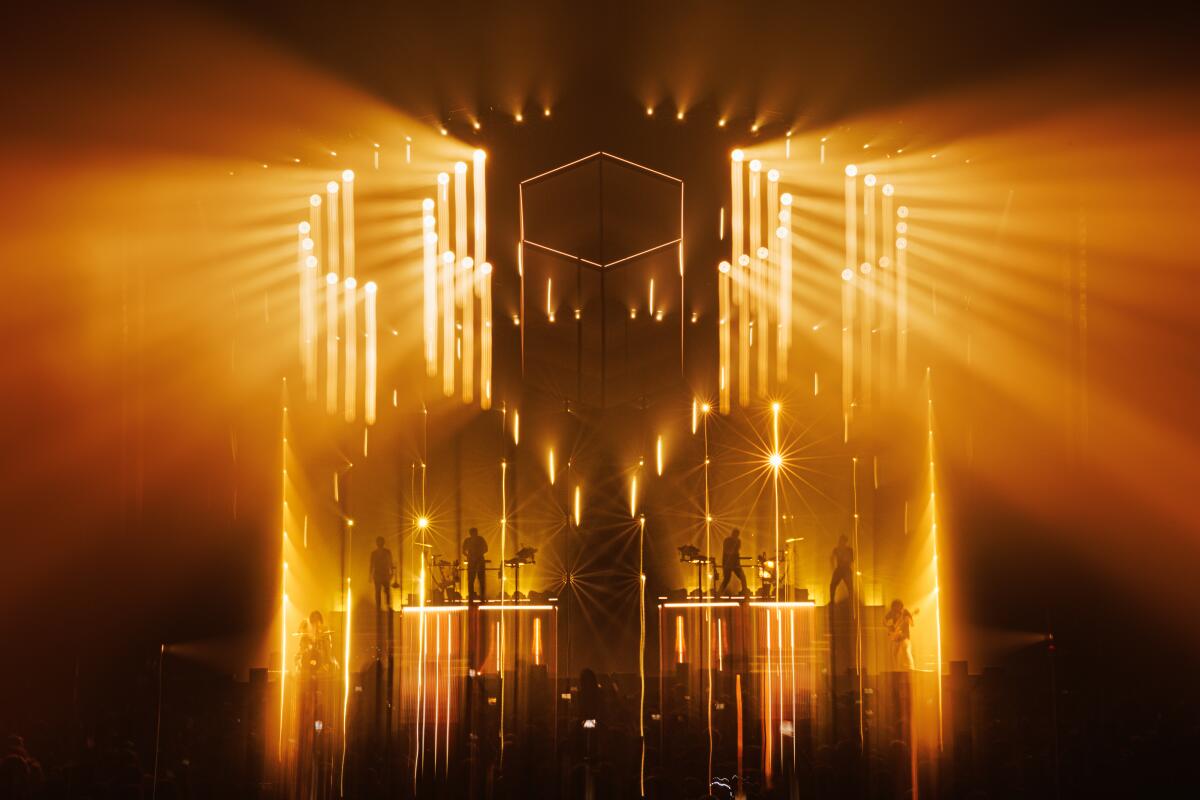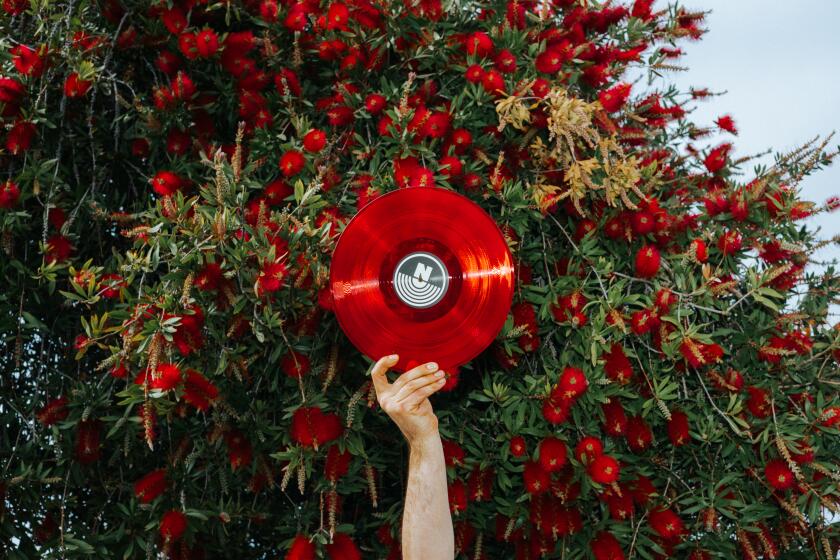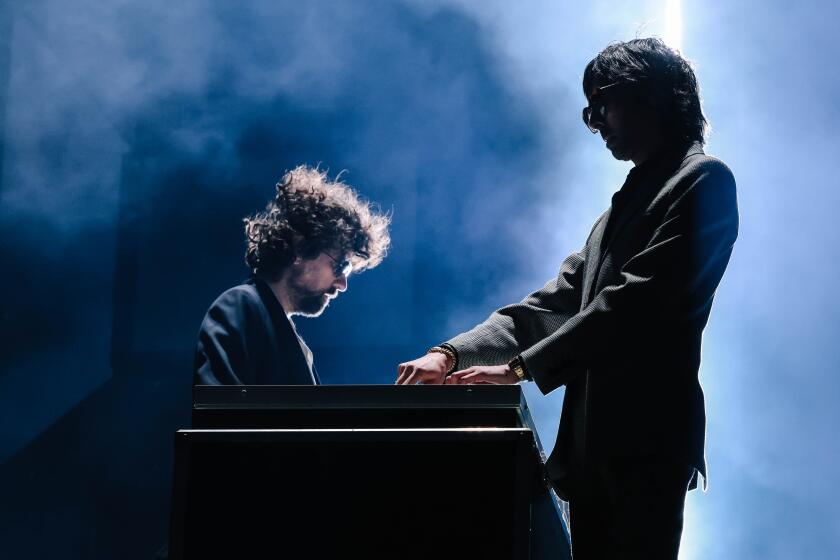Odesza takes a bow on ‘The Last Goodbye Finale’ tour by going out on top at L.A. show

- Share via
Odesza will close the curtain on its latest cycle when “The Last Goodbye Finale” tour kicks off with two shows, Friday and Saturday, at L.A.’s BMO Stadium.
The last shows of their 2022 album cycle for the Grammy-nominated “The Last Goodbye” are the largest outings of the act’s career, with nine dates including stops at New York’s famed Madison Square Garden and the picturesque Gorge Amphitheater in their home state of Washington.
The eclectic EDM duo of Clayton Knight and Harrison Mills have no identifiable radio hits. Yet, since 2012, they’ve built one of the most fervent fan bases in electronic music with four studio albums, a handful of singles and EPs, and consistent touring.
Starting as like-minded college students at Western Washington University in 2012, the pair have become a symbiotic partnership known worldwide that lives in the space between rave culture and arena pop.
Influenced as much by the Beach Boys as they are by Moby and Animal Collective, Knight and Mills traverse decades of recorded sound to craft soundscapes through samples and soaring vocal features that range from heavenly to heavy — both sonically and emotionally. Their music has taken them from tiny clubs to top-line and headlining performances at festivals including Coachella, Lollapalooza, Austin City Limits and Bonnaroo.
The music is brought to life through a cinematic production that has few parallels in modern concert presentation, creating sensory overload through large-scale visuals, bursts of fire, canopies of lasers, confetti cannons, and — what has become the duo’s live signature — an epic drumline that provides percussive wallop and eye-popping entertainment.
Odesza will pay homage to everything they’ve done in their career so far with the finale, which they say will be the longest show they’ve produced. Recently The Times spoke with Knight and Mills about the album and what inspired it, their creative process, what fans can expect from the finale, and more.
Odesza seemingly levels up with each album cycle. With the creation of the album “The Last Goodbye,” what were you trying to do and convey?
Mills: We’re always paying attention to evolving. It’s really important to us to change and move forward and not rest on our laurels too hard. But we don’t want to lose the thing that makes us us. We’re really focused on trying lots of ideas and seeing where that takes us. And then the things that stick tend to be the guiding light for us. If we keep gravitating towards one song, it becomes this goal post for us.
That’s a big reason why “The Last Goodbye” was our first single. It’s this big journey track. It pushes forward a lot of sounds that we were trying to make before, and also new things. We use that as the tent pole for us to decide what this record means. What’s the journey we’re trying to take people on? What’s our new sound?
We were trying to answer those questions throughout a lot of COVID. We wanted to look back and not feel like we were trying to just lean into the sadness there. We wanted it to feel hopeful, and feel like something bringing people back together when the world opened up again.
Knight: Headphone-based records have been a lot of what we’ve leaned into. And of course, we love enjoying music that way. This one definitely is a little more dance oriented and started with the idea that you want to play it out with your friends and be in those communal spaces because that was such an important aspect of coming out of the pandemic.
You can hear the snippets, family recordings and stuff. That was a starting point for us, just looking back at how we got to where we were, and who made us who we are. So a lot of these tracks started as just an ode to our family and friends. We wanted to have that unearthing and be a little more vulnerable than we’ve been in the past.
Mills: A big part of the record was trying to take these things from the past, make them modern, but also do it in our own way that adds our unique twist on it. It’s pretty hard to do that and not screw up some great music. For instance, Bettye LaVette and [the song] “The Last Goodbye.” That’s such a powerful, incredible record, and you want to respect it and do it correctly. Getting her blessing through it all was such an incredible experience for us.
Knight: There’s a lot of these Moby references, throughout — the kind of golden era of electronic music, being like Boards of Canada, Four Tet stuff. We really tried to go back to what we fell in love with in the first place, add our twist to it, and bring it a little more in the modern world. So, using sampling techniques, and then trying to use as many modern synth elements to give it this blending of two worlds. That was definitely a big task. But something we really enjoyed doing.

Listening to Catacombkid and BeachesBeaches (Knight and Mills pre-Odesza solo projects), you were doing similar things separate from each other, and then found each other. How serendipitous or weird was that, to find almost your musical mirror?
Mills: Yeah, it’s very love at first sight. I feel like it’s weird, because you say musical mirror, but I think we’re super different, but the same. That’s what makes it work is, we push each other in different directions, but it’s for the same goal.
And that combination is really potent. That’s what excited us when we first met and we were jamming together. He would add something I would have never added myself. But then it made so much sense to me once I heard it. And I think we were doing that back and forth. And you feed off that energy.
I spent that entire summer just driving back up to Bellingham [Washington], where we went to school, just to keep jamming with Clay because it just felt so special. We both thought we were going to have to get real jobs pretty soon. So it was like our last hurrah. And that’s what our first record was.
Knight: We both went to Western Washington University. It’s very band focused. There’s a lot of folk rock, even a lot of punk. We were the only guys leaning into electronic stuff really.
Cheryl Waters of Seattle radio station KEXP said your sound feels like the Pacific Northwest. How would you explain that to people who haven’t been there?
Mills: Because of the weather, you’re usually stuck inside. So it harbors a lot of creativity, from just being inside. I think we’ve spent so many days overcast and rainy and us in our rooms trying to make music and experimenting with noises and stuff.
Knight: The weather is such an important part of our background. I think we do a lot of really good writing when you’re hunkered down. But there is this longing for this warmth, longing for this bright stuff that you just don’t get from the weather. So we put it in the music, to create some sort of that feeling back.
Mills: We’re fighting seasonal depression.
You create arena-ready music with pop hooks and emotive elements that people latch on to. How do you choose your collaborations?
Knight: When we first started collaborating with vocalists, we were just doing random vocal sessions with writers. And we’re hitting a wall here and there, because the music wasn’t coming together in a genuine enough way.
What we started doing is just work with artists we really wanted to work with, no matter what size. Honestly, the smaller artists, maybe a little less known, aren’t so boxed into a sound. They’re a little more willing to explore and push their boundaries.

Odesza is known for the live show. How did your show evolve to the place where it is now, and how do you expand upon that for a finale?
Mills: It started when we first did our first show. We had no idea how to make a live show. We found [an] Ableton template of how to make a live set. And then we just started building off that.
While that seems wrong and silly, what it did is it really allowed us to not only have the freedom to keep changing it, but also learn in real time what works, what doesn’t work, how to adapt our sound, how to change our sound.
Now I think we’ve done enough shows where we can start imagining what things are going to be like live. And because we’ve slowly built this community of people that want to see us, I think they’re more willing to indulge in these more cinematic things or theatrical things that we’re trying to convey.
Us being fans of film and soundtracks — and all these other things — and that coming into the music, we just try to emphasize it in the live show. We’re really lucky that people are along for that ride.
Knight: There’s always something to prove for us in some of these settings, because we didn’t have a massive single to lean on, which we can play at the end where no one really cares what you do through the rest of the set. … All of it has to be good. People have to walk away being like, “What the f— did I just watch?”
More to Read
The biggest entertainment stories
Get our big stories about Hollywood, film, television, music, arts, culture and more right in your inbox as soon as they publish.
You may occasionally receive promotional content from the Los Angeles Times.












